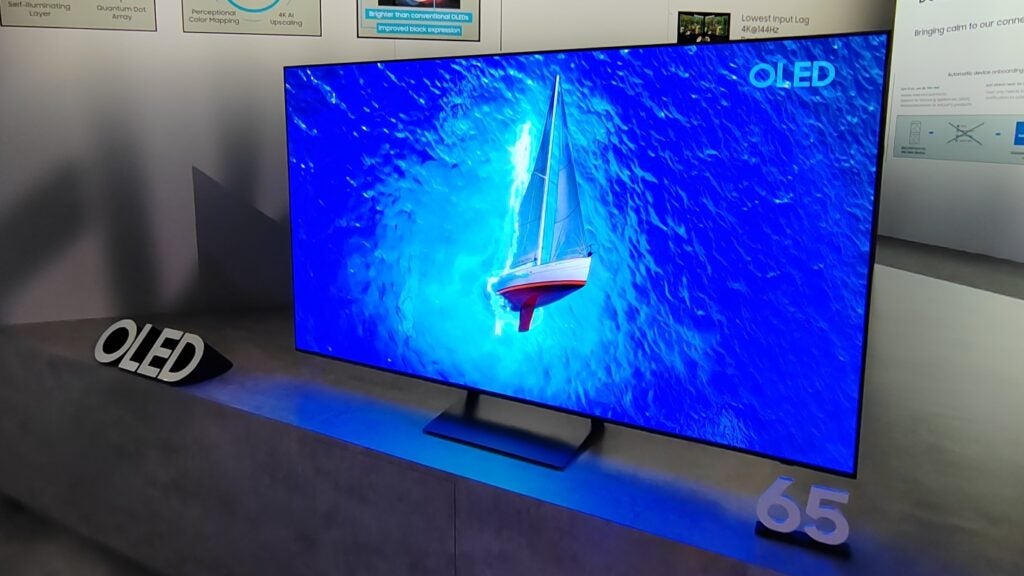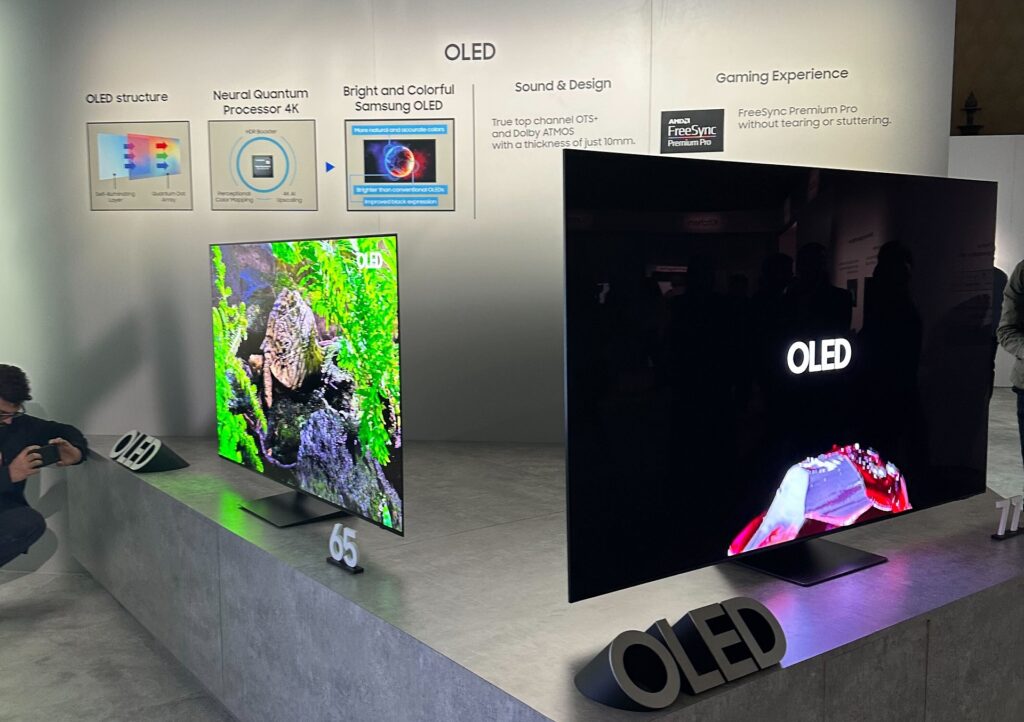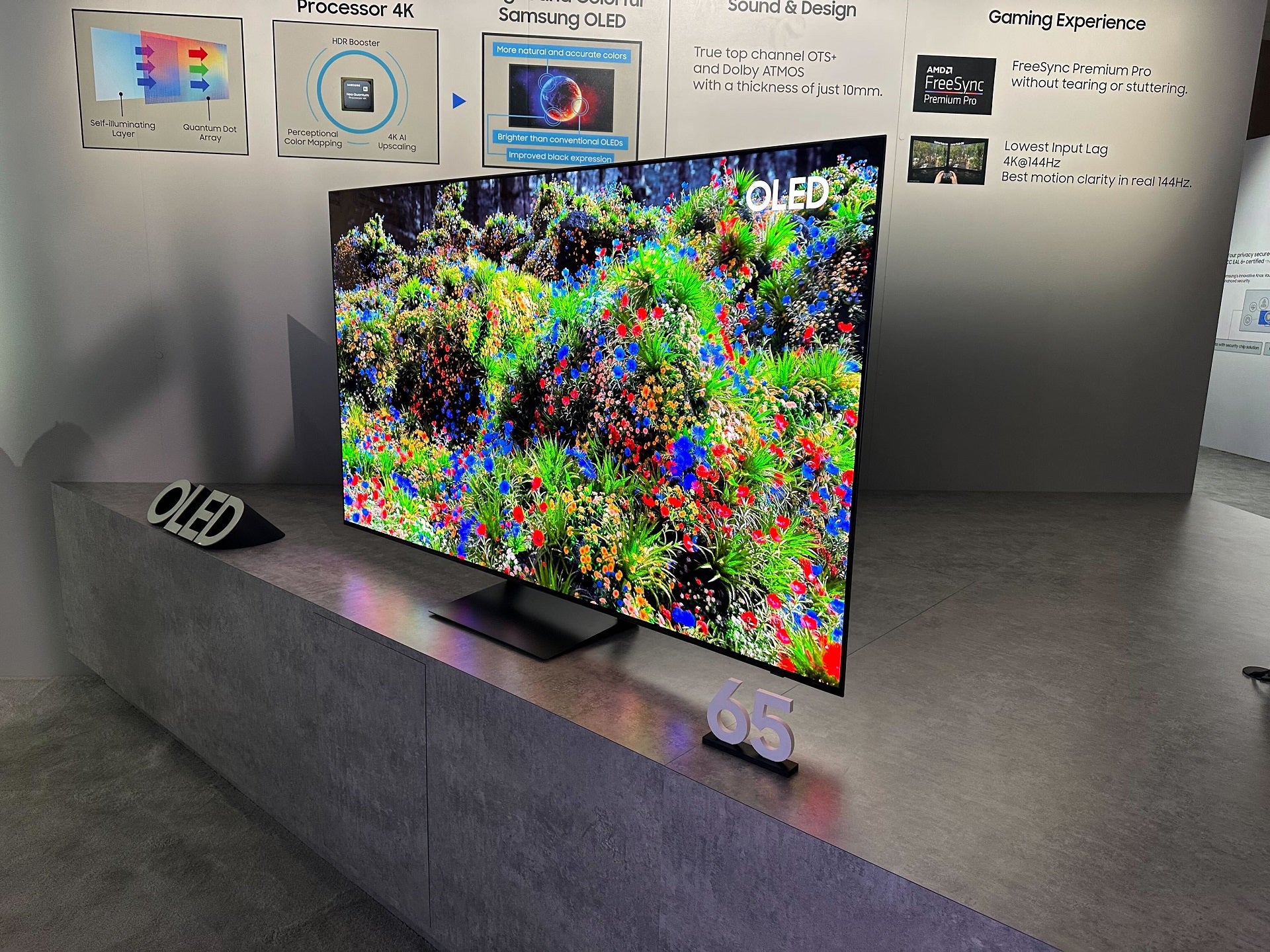With the S95C, Samsung is throwing down the gauntlet to OLED rivals. A dramatic upgrade to its nascent QD-OLED technology, this new screen is not only brighter than its predecessor, the S95B, but even more visually nuanced and well specified.
Pros
- HDR performance looks outstanding
- Excellent viewing angles
- OTS+ sound with Dolby Atmos
Availability
- UKTBC
- USATBC
- EuropeTBC
- CanadaTBC
- AustraliaTBC
-
HDR supportHDR10, HDR10+ Adaptive and HLG -
Picture modesFilmmaker mode to preserve artistic intent of content -
GamingAMD FreeSync Premium Pro support
Introduction
Samsung may still be something of a challenger brand in OLED, but this second generation flatscreen looks to move QD-OLED technology firmly into pole position, with class leading brightness and outstanding colour fidelity. It’s not without designer flair either…
I’ve had the chance to take a close look at this new 4K entrant, first auditioning it in prototype form at Samsung Display’s OLED factory in Yongin, South Korea, then getting up close and personal at Samsung’s First Look event at CES 2023. These are my early impressions…
Design
- LaserSlim design
- Just 10mm thick
- Next generation QD-OLED panel
The S95C may usher in a significant change in OLED panel design, but Samsung hasn’t sacrificed good looks in the process. Adopting the same LaserSlim design as its predecessor, the bezel is tantalisingly thin, little more than a frame around glass. A central foot keeps the set upright and ensures it’s easy to accommodate on AV furniture.
Despite the inclusion of Samsung’s speaker rich OTS+ sound system, the 65-inch S95C is just 10mm thick.
For 2023, Samsung is actually expanding the number of QD-OLED screens sizes available. In addition to 55- and 65-inch models, there’s a whopping 77-inch model on the cards.

As ever, significant changes can be found under the hood. Samsung says the brightness boost delivered by the S95C comes from two key innovations: a more efficient ETL (electron transport layer) plus Intellisense AI v2.0 pixel control.
By upgrading the material used in the ETL, Samsung engineers have been able to minimise light absorption and increase the resonance of light emanating from the panel, so we get a brighter screen with improved black level gradation.
Subjectively, that certainly seems to be the case…
Picture Quality
- Class leading HDR brightness
- Vibrant colour performance
- Good off axis viewing
Let’s put things in context: OLED TV brightness is getting a bump across the board in 2023, thanks to a variety of panel innovations, including integrated heatsinks and brightness boosting algorithms.
Every OLED TV manufacturer worth its salt is claiming improvements.
But Samsung, thanks to QD-OLED’s unique design, seems able to push this picture aspect further than most. The S95C positively glows with good health. Its peak HDR highlights are piercing, which this makes for a truly dramatic presentation. There’s something gloriously intense about its imagery. At times, pictures seem almost three dimensional, and off axis viewing is excellent.
Samsung is claiming a peak HDR brightness of 2000 nits for the S95C, compared to 1500 on its first gen QD-OLED.
By comparison, rival White OLED panels (at least those circulating in 2022), as made by LG Display, have an optimum performance that typically varies between 1,000 – 1150 nits, when measured using a 3 per cent window.
Obviously, paper specs need to be taken with a pinch of salt. The quoted numbers are optimum values based on raw panel performance, so I expect them to be influenced by the processor and final design of the sets they inhabit.

I also don’t know how they’ll compare in the real world against the latest MLA (Micro Lens Array) panels coming out of LG Display. We’ll all have to wait for finished samples to find out for sure.
But subjectively, the S95C looks to be a phenomenal performer – and it’s not just brightness that catches the eye. The screen’s colour performance is remarkable. Demo clips of green forest foliage, and autumnal leaves with pine cones, are gorgeous. Hues are rich, but not exaggerated. There’s a hyper-realism about its images that’s mesmerising. Derren Brown would be proud. Skin tones look naturalistic and are consistently believable.
Driving the new panel is the brand’s latest Neural Quantum processor 4K, with AI assisted perceptional colour mapping. Samsung says we can expect a 30 per cent uplift across primary colours, which each enjoy the same luminance boost.
The near black performance is also first rate, with copious shadow detail. Cinematic? I think so, albeit in a different way from what I’ve seen on Panasonic’s upcoming MZ2000 OLED. The S95C is a little more in your face.
Despite the S95C’s powerhouse picture performance, expect reduced power consumption and improved reliability; the panel’s expected lifespan is said to be twice that of its first gen QD-OLED.
Sound Quality
- Object Tracking Sound +
- Dolby Atmos
- Q Symphony compatible
The S95C may be fashionably thin, but it still manages to pack an impressive speaker array, with a top-mounted speaker to deliver Dolby Atmos height content, and up-mixed material.
This should give it the edge over last year’s model, but I’ll have to reserve judgement until I’ve put it through its paces. Power output is thought to be the same as the S95B, which was rated at 40W total.
The good news is the S95C will work with 2023 Samsung soundbars for a full Q-Symphony (all-speakers blazing) listening experience.
Features
- Four 4K/120Hz capable HDMI inputs
- eARC
- Tizen Smart Platform
Usability looks to be good. The S95C runs the latest iteration of Samsung’s Tizen smart platform, which remains one of my favourite smart TV interfaces. Expect a full complement of premium streaming services and plenty of catch-up apps. UK users shouldn’t lament the absence of Freeview Play, as all the mainstream channels are likely to be supported.

One additional bonus is Samsung TV Plus, a linear streaming TV service with a multiplicity of channels. There’s plenty of stuff to explore here, so you shouldn’t run out of free TV to watch.
All four HDMI inputs are HDMI v2.1 compliant and support 4K/120Hz playback. There’s also eARC, VRR (variable refresh rate) with AMD FreeSync Premium Pro support, with ALLM (auto low latency mode) for console gamers.
First impressions
The Samsung S95C is looking every inch a front runner when it comes premium OLED screens in 2023. This new model brings fresh refinement to QD-OLED, and delivers a remarkably bright panel with phenomenal colour depth.
I also like the slim design, and Tizen smart platform offering.
What remains to be seen is how much this new model will cost, and how it comes out against its next generation WOLED rivals. Expect the S95C to arrive spring 2023.
FAQs
QD-OLED is a combination of a Quantum Dot colour filter and OLED screen that allows for a wider range of colours to be shown and higher level of brightness to be reached.
Jargon buster
QD-OLED
QD-OLED or Quantum Dot display is an emissive display that combines Quantum Dot colour technology and OLED-like contrast, viewing angles and perfect blacks. QD-OLED can also hit brighter overall and peak levels for HDR content
HDR10+ Adaptive
Like Dolby Vision IQ, HDR10+ Adaptive uses a TV’s light sensor to adjust luminance, colours and black levels according to the amount of ambient light in a room for the best picture at all times
























